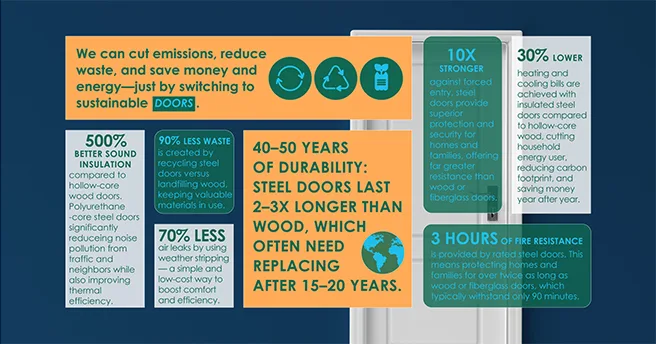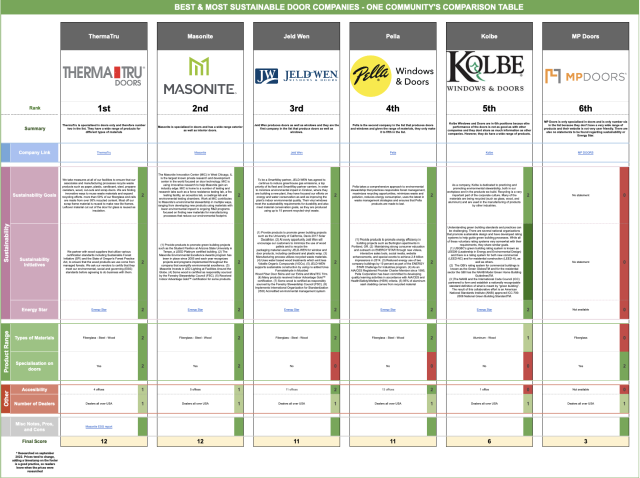
Most Sustainable Doors & Door Companies
Using the most sustainable doors and door companies to minimize energy use for building heating and cooling is a major component of One Community’s open source strategy for building a global collaboration of self-sufficient and self-sustainable teacher/demonstration communities, villages, and cities for The Highest Good of All. Just by using proper door insulation, especially with the newer technologies, energy efficiency can be improved significantly. With this in mind, we have researched the best energy efficient doors as part of our open source contribution to comprehensive sustainable living. Below you will find an overview of the best doors. It contains the following sections:
- Related Pages
- Why Identify the Most Sustainable Doors
- Ways to Contribute and Consultants
- Understanding Doors
- Best & Most Sustainable Door Companies
- Best and Most Sustainable Doors Overall
- #1: Masonite Sta-Tru Prehung Entry Door
- #2: Masonite Fiberglass Prehung Entry Door
- #3: ThermaTru Steel Traditions Entry Door
- #4: Jeld Wen Steel Entry Door
- #5: Pella Steel Entry Door
- #6: Jeld Wen Fiberglass Entry Door
- #7: Pella Fiberglass Entry Door
- #8: ThermaTru Fiberglass Entry Door
- #9: MP Doors Fiberglass Door
- #10: Pella Springline Wood Entry Door
- #11: Kolbe Vistaluxe Wood Entry Door
- #12: Kolbe Vistaluxe Aluminum Entry Door
- Resources
- Summary
- FAQ
This research is 100% independent and by volunteers. We have not been paid or incentivized in any way.
RELATED PAGES (mouse-over for descriptions and click for complete pages)
WHY IDENTIFY THE MOST SUSTAINABLE DOORS
While windows may outnumber doors in a house or building, the choice of the right door remains pivotal for maximizing energy efficiency. A well-selected door should prevent unwanted cold infiltration and retain generated warmth, ultimately contributing to the sustainability of a structure. Modern sustainable doors offer an exceptional combination of enhanced insulation, sustainable materials, and appealing aesthetics. In this article, we present a comprehensive overview of the best and most sustainable door companies and products currently available in the market.
Drawing from 50+ hours of research, we have produced our guide to doors to support your projects as well as our own. As we build our Earthbag Village and Duplicable City Center, we will update this page to share our experiences and the insights we gain on doors along the way. Further, we will continue to expand our research and may update our door selections accordingly as new information becomes available.
WAYS TO CONTRIBUTE TO EVOLVING THIS SUSTAINABILITY COMPONENT WITH US
SUGGESTIONS | CONSULTING | MEMBERSHIP | OTHER OPTIONS
CLICK THESE ICONS TO JOIN US THROUGH SOCIAL MEDIA
RESEARCHER FOR THIS COMPONENT:
Ian Coletti: Sustainability Engineer
Philip Bogaerts: Structural Designer
Julia Meaney: Web and Content Reviewer and Editor
Charles Gooley: Web Designer
UNDERSTANDING DOORS
While having an energy-efficient window is crucial, neglecting to consider an appropriate door for your design would be a missed opportunity. Failing to install the right door could potentially negate the energy savings achieved through sustainable window selection. While interior doors hold relatively less significance due to house-wide heating, it’s imperative that all exterior doors prioritize security and energy efficiency. In this section, we explore the different door types on the market as well as the sustainability and properties of various door materials.
DOOR TYPES
This page lists only the most common door types, but it is important to note that these are not the only kinds of doors available in the market. Before discussing entry doors in more detail, we will provide an overview of several basic door types.

Single Leaf Entry Doors
Single Leaf Entry Doors are the most sustainable choice for regular home entrances. In their best form, they are solid barriers against the elements and outside temperatures. Their simple utilitarian construction allows them to function the most like walls, which are still the best type of insulation.
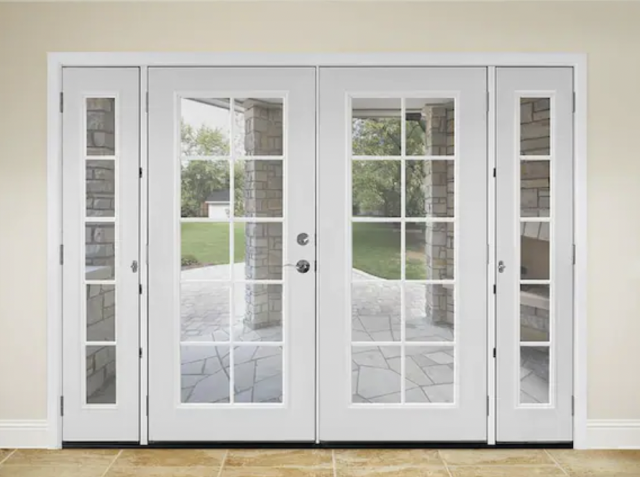
French Doors
French Doors are hinged doors with two panels and are usually designed with large windows. While they are a better choice than most patio doors for backyards and the like, two panels still leave more edges to seal than one. Even with weatherstripping, temperature transfer through door seams remains a problem for efficiency.

Patio Doors
Patio Doors are transparent entrances which may be hinged or sliding. Though they are different in function from windows, their constructions are very similar and they are often sold as part of window lines. However, because of their functionality they are part of the door section.
DOOR MATERIALS
Assessing the exterior materials of doors involves an examination of their durability, thermal and acoustic insulation, as well as their overall life cycle sustainability. These categories provide valuable insights into the true sustainability of a door. A door with exceptional durability not only maintains efficiency over an extended period but also boasts a prolonged lifespan, consequently reducing resource consumption. Adequate insulation also plays a pivotal role, enhancing energy efficiency significantly. The concept of life cycle sustainability encompasses the environmental impact arising from material production, as well as its potential for long-term reuse and recycling. Notably, embodied energy stands as a crucial determinant, quantifying the fossil fuel emissions from the door’s fabrication to its eventual disposal or recycling. Outlined below is an overview of various door materials, ranked from most to least favorable, for use in entry doors:
STEEL

Steel is ranked as the most favorable entry door material. The main advantage of steel doors is that they are manufactured as a steel casing which covers an inner polyurethane core, making it very energy efficient. These types of doors are very fire resistant, highly durable, and don’t require much maintenance. From an aesthetic point of view, they give a contemporary and sleek look, which is ideal for modern houses. On top of this, steel doors are endlessly recyclable, have a low embodied energy, and have a lifespan of +/- 40 years.
The most significant disadvantage of steel doors is the direct CO2 emissions that come from crude steel production; approximately 1.85 tons of CO2 per ton of steel is emitted. Further, steel doors are susceptible to scratches and dents, potentially leading to rusting and increased paint chips. They are also temperature sensitive, sometimes feeling very hot in the summer and very cold in the winter.
FIBERGLASS

Fiberglass doors are the best doors in terms of durability, security, and energy efficiency. They require little to no maintenance and offer different levels of fire resistance depending on the needs of the design. Their aesthetics are very similar to wooden or steel doors and they are not subject to environmental influences. Fiberglass is known for its very low embodied energy and on top of that, fiberglass doors have a lifespan of +/- 50 years.
Fiberglass is not ranked first due to its harms to human health. Inhaling slivers of fiberglass can irritate the alveoli and cause health problems, especially in the lungs. Additionally, fiberglass doors consist of fibers which are biodegradable but are not easily recyclable. Fiberglass production emits approximately 1.0 ton of CO2 per ton of fiberglass. These doors are also three to four times more expensive than steel doors.
ALUMINUM

The primary advantage of aluminum doors is that they are light in weight but maintain strength, making them durable. Aluminum doors require no maintenance and since aluminum is a highly sustainable material, these doors are endlessly recyclable. Another advantage of these doors is that they are relatively cheap and can be powder coated in any color, making them easy to match with your design.
The most significant disadvantage of aluminum doors is that the direct CO2 emissions of aluminum production is approximately 2.0 tons of CO2 per ton of aluminum. On top of this, their performance values are far from as good as fiberglass and steel front doors. Aluminum doors are also not considered great in terms of security as they are not as strong as fiberglass, steel, or wooden doors and they are not as aesthetically pleasing. When it comes to their durability, they have a lifespan of +/- 20 years, which is significantly less than fiberglass and steel doors.
WOOD

Wooden doors are arguably the most aesthetically pleasing doors available in the market. It is possible to carve designs out of wood, making them a very easily customizable door. Apart from their aesthetic qualities, they also have great thermal and acoustic performance values. Wooden doors can last for a very long time with a lifespan of +/- 55 years which is similar to fiberglass doors, but unlike fiberglass doors, they need regular maintenance.
However, the disadvantages of wooden doors outweigh the advantages. When used as an exterior entry door their absorption of moisture makes them subject to contraction and expansion and also makes them prone to cracks. Additionally, wooden doors are prone to termites and need regular maintenance to keep their warm appearance. Most importantly, these doors are very expensive and are regularly up to ten times the price of steel doors.
UPVC

uPVC doors are not only energy efficient, but they are also sound proof and fire resistant. Additionally, these doors are resistant to dust and chemicals and do not rust, rot, or flake. With a lifespan of 35 years, they are good value for money.
The primary disadvantage of these doors is that uPVC is a very light material and is not strong enough to be used for an external security door. These doors are not aesthetically pleasing, giving a more plastic look. As well as this, the performance of these doors may decrease significantly over time due to weather conditions that cause the uPVC to shrink and expand. Approximately 1.6 tons of CO2 are emitted per ton of uPVC produced.
GLASS

When it comes to glass, the main advantage of using it for an external door is that it allows natural light to enter. Glass doors are more common for interior spaces since they tend to make a room look bigger and they offer transparency. However, thermal insulation is not as important for interior glass doors, which ultimately allow more light to flow through a space.
The primary disadvantage of glass as a material for exterior doors is that glass in itself is not an energy-efficient material. For exterior door use, you would need an insulating glass unit with a coating applied to it. Further, these doors are susceptible to scratches and don’t offer a lot of privacy; though this can be helped by using stained, translucent, or textured glass which comes at an extra cost. As a result, these doors are not ideal as external/front doors. When these doors are properly installed, they can have a lifespan of +/- 30 years.
BEST & MOST SUSTAINABLE DOOR COMPANIES
Here are the best and most sustainable doors we found from each company. Note that many features do not automatically come with each product and some may preclude each other. Also keep in mind that these are the best products as of December 2022. While new designs are constantly being created, this list can be used as a baseline for comparison even as it becomes dated. We wouldn’t recommend any new product that doesn’t at least meet the performance standards of the products listed here. We will also add to this page our top choices purchased as we build the Earthbag Village, Duplicable City Center, and other 6 sustainable village models. So expect this page to evolve for many years.
#1: MASONITE
 Masonite is ranked as the most sustainable door company thanks to its sustainability initiatives and goals. They have a private facility in the USA that focuses entirely on innovative, sustainable research, which ultimately gives this company the edge. Their focus is on developing materials for doors with the lowest possible environmental impact, as well as improving their existing models. Most of their products are certified and contribute to the LEED score of buildings. They have multiple offices and manufacturing plants throughout the USA as well as manufacturing sites worldwide. Masonite therefore has a lower ecological footprint as compared to its competitors.
Masonite is ranked as the most sustainable door company thanks to its sustainability initiatives and goals. They have a private facility in the USA that focuses entirely on innovative, sustainable research, which ultimately gives this company the edge. Their focus is on developing materials for doors with the lowest possible environmental impact, as well as improving their existing models. Most of their products are certified and contribute to the LEED score of buildings. They have multiple offices and manufacturing plants throughout the USA as well as manufacturing sites worldwide. Masonite therefore has a lower ecological footprint as compared to its competitors.
Masonite’s best products:
#2: THERMATRU
 ThermaTru Doors shows a tangible commitment to sustainability outreach and education, but information on their initiatives for improving company efficiency and sustainability is sporadic. ThermaTru recycles all recyclable materials and most of their fiberglass end rails are composed of 95% recycled materials. By partnering with wood suppliers that use various certification standards, such as Sustainable Forestry Initiative (SFI) and the State of Oregon’s Forest Practice Act, they ensure their wood is sourced from managed forests. In order to meet their Environmental, Social and Governing standards, they ask their vendors to certify that they meet their environmental, social and governing (ESG) standards before agreeing to do business with them. ThermaTru’s steel front door is one of the best front door options, and they also offer fiberglass and wooden doors. However, they only have one production site in Butler, Indiana, and one in Matamoros, Mexico.
ThermaTru Doors shows a tangible commitment to sustainability outreach and education, but information on their initiatives for improving company efficiency and sustainability is sporadic. ThermaTru recycles all recyclable materials and most of their fiberglass end rails are composed of 95% recycled materials. By partnering with wood suppliers that use various certification standards, such as Sustainable Forestry Initiative (SFI) and the State of Oregon’s Forest Practice Act, they ensure their wood is sourced from managed forests. In order to meet their Environmental, Social and Governing standards, they ask their vendors to certify that they meet their environmental, social and governing (ESG) standards before agreeing to do business with them. ThermaTru’s steel front door is one of the best front door options, and they also offer fiberglass and wooden doors. However, they only have one production site in Butler, Indiana, and one in Matamoros, Mexico.
ThermaTru’s best products:
#3: JELD WEN
 Jeld Wen shows some signs of environmental responsibility. The company is a member of the Smartway program and has an accredited environmental management system. They also make sure that their manufacturing processes and products are designed to minimize the emission of toxins. Many Jeld Wen products are awarded the Indoor Advantage Gold Certification for the level of safety they meet and some of the wood used in their doors is FSC certified. Aside from this, the company does not appear to match the sustainability practices of companies higher on the list despite its official, yet short, sustainability report. While Jeld Wen claims to recycle and use recycled materials in production, they do not provide any data on this. Jeld Wen production sites are found all over North America, Europe and Australia.
Jeld Wen shows some signs of environmental responsibility. The company is a member of the Smartway program and has an accredited environmental management system. They also make sure that their manufacturing processes and products are designed to minimize the emission of toxins. Many Jeld Wen products are awarded the Indoor Advantage Gold Certification for the level of safety they meet and some of the wood used in their doors is FSC certified. Aside from this, the company does not appear to match the sustainability practices of companies higher on the list despite its official, yet short, sustainability report. While Jeld Wen claims to recycle and use recycled materials in production, they do not provide any data on this. Jeld Wen production sites are found all over North America, Europe and Australia.
Jeld Wen’s best products:
#4: PELLA
 Pella Windows and Doors is a company that claims a commitment to sustainability outreach and education, but their publishing of information on their sustainability initiatives is sporadic. The company has made notable improvements such as an over 10% reduction in energy use in two company buildings. Pella also uses 95% recycled aluminum in their clad aluminum window sashes (the part that holds the glass in place), however, this same kind of information is not available for their outer frames. As far as could be found, Pella has very little in the way of a sustainability report. However, the company does participate in a variety of partnerships taking direct action towards sustainability. For example, they adhere to the Smartway plan to reduce the carbon footprint of its transportation routes. As an AIA/CES Registered Provider Charter Member, the Pella Corporation is committed to developing learning activities and courses on green building. Their promotion of sustainability has even been recognized by Energy Star.
Pella Windows and Doors is a company that claims a commitment to sustainability outreach and education, but their publishing of information on their sustainability initiatives is sporadic. The company has made notable improvements such as an over 10% reduction in energy use in two company buildings. Pella also uses 95% recycled aluminum in their clad aluminum window sashes (the part that holds the glass in place), however, this same kind of information is not available for their outer frames. As far as could be found, Pella has very little in the way of a sustainability report. However, the company does participate in a variety of partnerships taking direct action towards sustainability. For example, they adhere to the Smartway plan to reduce the carbon footprint of its transportation routes. As an AIA/CES Registered Provider Charter Member, the Pella Corporation is committed to developing learning activities and courses on green building. Their promotion of sustainability has even been recognized by Energy Star.
Pella’s best products:
#5: KOLBE WINDOWS & DOORS
 Kolbe Windows and Doors shows their commitment to creating a sustainable future through their promotion of environmental stewardship and recycling as an important aspect of the corporate culture. Their promotion of sustainability has also been recognized by Energy Star.
Kolbe Windows and Doors shows their commitment to creating a sustainable future through their promotion of environmental stewardship and recycling as an important aspect of the corporate culture. Their promotion of sustainability has also been recognized by Energy Star.
The reason this company has been ranked in 5th place is because they are lacking in widespread production sites, ultimately resulting in higher transportation costs and a larger negative impact on the environment. If this company is located local to you, however, they are a great option for your building. Another reason for their low ranking comes down to their limited door options in comparison to other companies; they only offer aluminum and wooden door products.
Pella’s best products:
#6: MP DOORS
 MP Doors is committed to creating a very durable door. Thanks to their Hydroshield Protection, their products are very well protected against water infiltration which allows them to maintain a great appearance over time. Their promotion of sustainability has also been recognized by Energy Star.
MP Doors is committed to creating a very durable door. Thanks to their Hydroshield Protection, their products are very well protected against water infiltration which allows them to maintain a great appearance over time. Their promotion of sustainability has also been recognized by Energy Star.
This company is ranked in 6th place as a result of the very limited available information on their production and operations. Their main product has good values and appears to be an interesting option, however not so much is known about it. Their main focus is on fiberglass doors which limits your options compared to some of their competitors. MP Doors also only deals in the United States and doesn’t have many production sites. This results in higher transportation costs and increased negative impacts on the environment.
Pella’s best products:
BEST AND MOST SUSTAINABLE DOORS OVERALL
The following doors have been selected from over 100 hours researching everything available on the online consumer market as of December 2022. In this section, we share the diversity of options that are available along with a thorough assessment of their internet reviews, price, durability, and the features we felt would make them enjoyable to use. There are many more options for doors than what we’ve listed here, so we tried to choose one from each of the various design options and explain why we ranked them as we did to highlight their functionality differences. Other energy-efficient doors exist and new designs are constantly being introduced, so we suggest you use the recommendations below as a guide, find the features you like most, and then explore the huge diversity of different manufacturers to find the look and function perfect for your project.
#1: MASONITE STA-TRU PREHUNG ENTRY DOOR

Masonite Sta-Tru Prehung Entry Door
This Masonite door is made of steel and contains a polyurethane core, which makes it an excellent thermal and acoustic insulator. This steel door is number one primarily because it can be recycled over and over again without reducing the quality of the door. When it comes to fire resistance, this door has a standard fire resistance of 20 minutes, and more fire resistant options of this door are available. A fire resistance of 90 minutes can be achieved by using a steel edge instead of the standard wooden edge.
This door has a lifespan of over 30 years and is very resistant to common wear and tear as well as to several weather conditions. In fact, this door is fully rust resistant. On top of that, there is a 20-year warranty and it comes at a low purchasing price. It can also be easily painted, making it customizable for your preferred design.
The main (and actually only) disadvantage with this door is the fact that the production of steel results in more air pollution than the production of fiberglass or wooden doors.
KEY FEATURES:
- Steel door – eternally recyclable
- Polyurethane core
- Excellent thermal and insulating performances
- 20-year warranty
ADDITIONAL INFORMATION
#2: MASONITE FIBERGLASS PREHUNG ENTRY DOOR

Masonite Fiberglass Prehung Entry Door
This Masonite door consists of Fiberglass and contains a polyurethane core. From a thermal point of view these materials are just below the steel door, but the fiberglass has better acoustic insulation. This door has a standard fire resistance of 20 minutes without a hose stream, and 90-minute fire resistant options are also available. An advantage of fiberglass over steel doors is that there is less pollution and emissions of things such as cobalt, nobelium, and sulfur from its production. The door has a lifespan of over 50 years and is very resistant to common wear and tear as well as to several weather conditions. On top of that, Masonite offers a 10-year warranty on these doors.
The main disadvantage with this Masonite door is that fiberglass is not endlessly recyclable and therefore not the most sustainable material. However, it is biodegradable and is overall not harmful to the environment. However, the production of fiberglass can cause short-term irritation to the nose and/or throat. Additionally, it is a much more expensive option than a steel door.
KEY FEATURES:
- Fiberglass door – not endlessly recyclable, but biodegradable
- Polyurethane core
- Excellent thermal and insulating performances
- 10-year warranty
ADDITIONAL INFORMATION
#3: THERMATRU STEEL TRADITIONS ENTRY DOOR
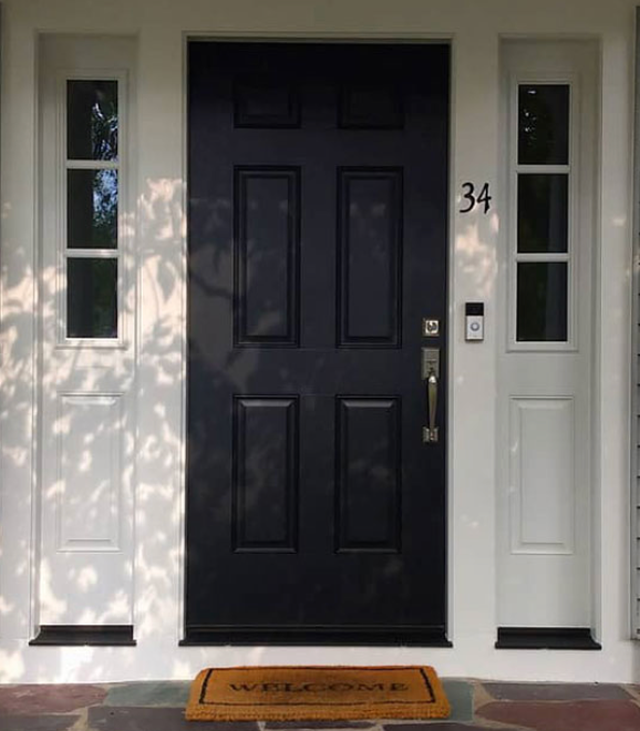
Thermatru Steel Traditions Entry Door
ThermaTru Steel Traditions door is their most sustainable front door option. This steel door has a polyurethane core, is recyclable, and is excellent at blocking heat flow. This door is relatively easy to produce and requires less material than its fiberglass counterpart. It is also the best thermal insulator in the list and has a very good acoustic performance. This door has a standard fire resistance of 20 minutes without a hose stream. It comes with a 5-year warranty and should have a 30-year lifespan.
This steel door is ranked in third position due to the fact that Thermatru doesn’t have many manufacturing sites, making it less accessible worldwide. Additionally, this door is a little bit more expensive than other options. Its primary disadvantage is that the production of steel doors results in more air pollution than the production of fiberglass or wooden doors.
KEY FEATURES:
- Steel exterior
- Polyurethane core
- Fire rated option
- 5-year warranty
- Poly-fiber composite frame
ADDITIONAL INFORMATION
#4: JELD WEN STEEL ENTRY DOOR
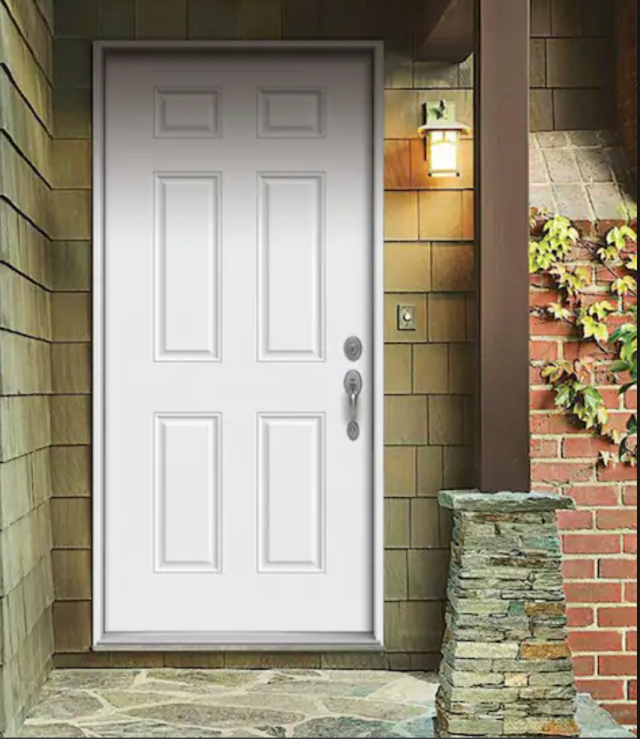
Jeld Wen Steel Entry Door
The Jeld Wen wood edge steel door provides good thermal and acoustic insulation. This door is predominantly made out of the recyclable materials steel and polyurethane (polystyrene). It has an Auralast Pine frame, meaning its production lessens VOC emissions and optimizes thermal performance. Standard versions have a fire resistance of 20 minutes without hose. This door is also fully recyclable and is a great option when seeking a good looking front door. Additionally, the standard version is amongst the least expensive steel entry doors and it comes with a 10-year warranty.
As with all steel doors, the main disadvantage to this door is that the production of steel results in more air pollution than fiberglass and wood. Acoustically, these doors are also not as good as their counterparts.
KEY FEATURES:
- Steel exterior
- Polyurethane or polystyrene core
- Wood edge for extra insulation
- Fire rated
- 10-year warranty
- Auralast Pine frame
ADDITIONAL INFORMATION
#5: PELLA STEEL ENTRY DOOR

Pella Steel Entry Door
Pella’s steel entry door has a polyurethane core, which is great at providing sufficient thermal insulation. This door also has great acoustic insulation, is fully recyclable, and has a poly-fiber composite frame. Apart from the standard 20-minute standard fire resistance, an optional fire rated frame can be applied for increased fire resistance. This Pella product comes with a limited lifetime warranty. Also, this door scores very high in terms of aesthetics as its interior surfaces are composite so that it can match the exterior finish perfectly.
KEY FEATURES:
- Steel exterior
- Polyurethane core
- Fire rated option
- Limited lifetime warranty
- Poly-fiber composite frame
ADDITIONAL INFORMATION
#6: JELD WEN ARCHITECTURAL FIBERGLASS ENTRY DOOR

Jeld Wen Architectural Fiberglass Entry Door
The Architectural Fiberglass doors by Jeld Wen are very energy-efficient, durable, and resistant against moisture. The doors are available in different sizes and can easily be customized to your preferred design. The standard version already has great acoustic insulation values and these doors are fire rated. However, they are rather expensive and are also not fully recyclable. Their limited lifetime warranty is definitely an asset when considering the right door for your home.
KEY FEATURES:
- Fiberglass exterior
- Polyurethane core
- Fire rated
- Limited lifetime warranty
ADDITIONAL INFORMATION
#7: PELLA FIBERGLASS ENTRY DOOR

Pella Fiberglass Entry Door
Pella’s Fiberglass entry doors provide very good acoustic and thermal insulation, but are ranked lower due to the less efficient production and recycling cycle of fiberglass. However, fiberglass requires less material by weight and may be more resistant to common wear and tear, which results in a longer lifespan. This door has a poly-fiber composite frame and in addition to the standard 20-minute fire resistance, an optional fire rated frame can be applied. From an aesthetic point of view, the interior can be matched perfectly to the exterior.
KEY FEATURES:
- Fiberglass exterior
- Polyurethane core
- Fire rated option
- Limited Lifetime warranty
- Poly-fiber composite frame
ADDITIONAL INFORMATION
#8: THERMATRU CLASSIC CRAFT FIBERGLASS ENTRY DOOR
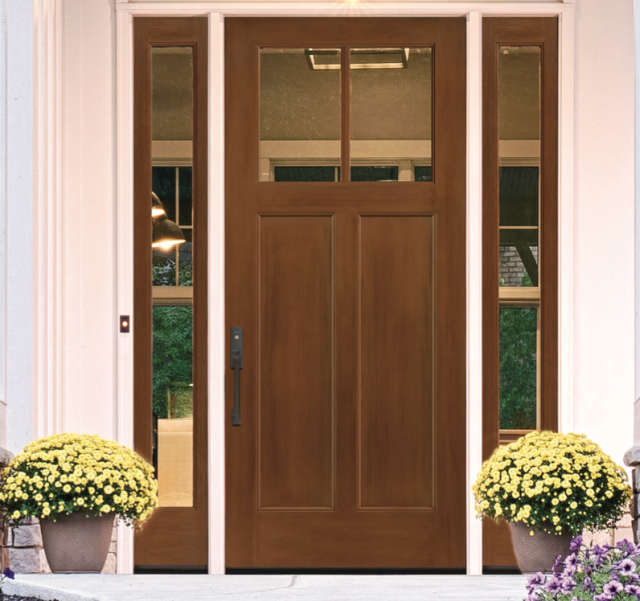
Thermatru Classic Craft Fiberglass Entry Door
Just like ThermaTru’s steel entry door, the fiberglass entry door has a polyurethane core which is fully recyclable and provides sufficient thermal insulation. One of the main advantages of this fiberglass door is that it is lighter and requires less material than their steel doors. On top of that, it is also more resistant to common wear and tear. Of course, these doors cost much more than the steel entry doors and are a little bit less sustainable due to their lack of an endless recycling cycle.
While this door has very good acoustic values, its thermal performance is a little bit worse than other doors. However, its 50-year lifespan and lifetime warranty (1x transferable) makes it one of the best options in terms of durability.
KEY FEATURES:
- Fiberglass exterior
- Polyurethane core
- Fire rated option
- Lifetime warranty
- Poly-fiber composite frame
ADDITIONAL INFORMATION
#9: MP DOORS FIBERGLASS DOOR

MP Doors Fiberglass Door
This MP Doors fiberglass door comes with complete composite edging and a full composite frame system that is 100% waterproof and resists rotting, warping, splitting, delaminating, denting, and rusting. It is loaded with energy-efficient features designed to bring down your energy costs year-round. The triple pane decorative glass also ensures that the door remains as energy efficient as possible while allowing natural light to come through. This product is Energy Star certified and has a lifetime warranty. It claims an estimated 50-year lifespan and its factory-assembled prehung door system results in an easy installation.
The disadvantages to this door include its relatively expensive price and the fact that there are not many production sites, which leads to higher transportation costs. Also, while it is a very energy efficient door, its acoustic values are not great. Finally, MP Doors lacks updated and accessible sustainability reports despite its Energy Star certification.
KEY FEATURES:
- Fiberglass exterior
- Polyurethane core
- Fire rated
- Lifetime warranty
- Fiberglass lite frame
ADDITIONAL INFORMATION
#10: PELLA SPRINGLINE WOOD ENTRY DOOR

Pella Springline wood Entry Door
Pella’s Springline wood entry door is a very sustainable door that is minimally harmful to the environment. This, in combination with its great aesthetic appearance and durability (they can last over 50 years), is the biggest advantage of these doors.
However, there are many more disadvantages: These doors need regular treatment against mold and bacteria. It is also only a class C door and therefore not as fire resistant as other materials. This door’s insulating value is up to 30% lower compared to the ‘most insulating doors’ and on top of that, it is a very expensive product. For the above reasons, this door is ranked 10th in the list.
KEY FEATURES:
- Wooden exterior / core / interior
- Great appearance
- Fire rated class C
- 5-year limited warranty
ADDITIONAL INFORMATION
#11: KOLBE VISTALUXE WOOD ENTRY DOOR

Kolbe Vistaluxe Wood Entry Door
The Kolbe VistaLuxe wood entry door is a sustainable door that is not harmful to the environment. This, in combination with its great aesthetic appearance and its durability (it can last over 50 years), is the biggest advantage of this door.
Unfortunately, however, this door has a bad insulating value; up to 50% lower than the best insulating doors. Further, with few production sites, it has higher transportation costs than its peers. This door also needs regular treatment against mold and bacteria and is sold at an expensive price. Additionally, this is also only a class C door and therefore is not as fire resistant as other materials.
KEY FEATURES:
- Wooden exterior/core/interior
- Great appearance
- Fire rated class C
- 10-year limited warranty
ADDITIONAL INFORMATION
#12: KOLBE VISTALUXE ALUMINUM ENTRY DOOR

Kolbe Vistallux Aluminum Entry Door
The Kolbe VistaLuxe aluminum entry door is in last position for several reasons. Although aluminum can be recycled endlessly, the extraction of aluminum is extremely harmful to the environment. These aluminum doors are the worst insulators, even more so than wooden doors. These doors are also no good for security and nor are they as durable (lasting only 20 years) as those mentioned above. As well as this, there are no price indications regarding this door.
There are some positives to this door, such as it being customizable to your taste, providing an aesthetically pleasing option. As well as having good overall acoustic insulation values, these doors are lighter and easier to install than others. Ultimately however, this door has many more negatives than positives.
KEY FEATURES:
- Easy customizable
- 10-year limited warranty
- Aluminum, usually combined with glass parts
ADDITIONAL INFORMATION
RESOURCES
- Window + Door: Top 100 Manufacturers 2019 Report
- Consumer Reports: “Entry Door Buying Guide”
- Energy Saver: Selecting New Exterior Doors
- Embodied Energy Coefficient
- Green Building Solutions: What is Sustainable Building?
- U.S. Green Building Council – Performance Score to LEED Certification
- Sustainable Forestry Initiative
- Oregon Forest Practices Act: About the Oregon Forest Practices Act (FPA)
- Masonite ESG Standards
- U.S. Environmental Protection Agency: SmartWay
- SCS Global: Indoor Air Quality Certification – For Furniture and Building Materials
- MP Doors Hydroshield Technology
- 2010 Energy Star Door Qualification Criteria
- Masonite Sta-Tru Prehung Entry Door | Specs
- Masonite Fiberglass Prehung Entry Door | Specs
- ThermaTru Traditions Steel Door | Specs
- ThermaTru Doors Performance Data Sheets
- Jeld Wen Steel Entry Door | Specs
- Jeld Wen AuraLast® Wood
- Pella Steel Front Door | Specs
- Jeld Wen Architectural Collection Fiberglass Door | Specs
- Pella Fiberglass Front Door | Specs
- ThermaTru Classic Craft Fiberglass Front Door | Specs
- MP Doors Fiberglass Entry Door | Specs
- Pella Springline Wood Front Door | Specs
- Kolbe VistaLuxe Wood Entry Door | Specs
- Kolbe VistaLuxe Aluminum Entry Door | Specs
- Suggest an addition to this section by clicking here
SUMMARY
One Community has invested over 50 hours of research into producing this comprehensive guide to doors which presents our rankings of the best and most sustainable door companies and products. Our goal is to open source share our experience with all of the doors we use as part of the development of the Earthbag Village and Duplicable City Center. We will continue to evolve this page with further details for guiding our purchasing decisions as we build the other 6 sustainable village models, as well as door selections for your own projects.
FREQUENTLY ANSWERED QUESTIONS
Q: What does FSC mean?
FSC stands for the Forestry Stewardship Council, an organization which certifies that the wood supplied to various companies is sustainably sourced.
Q: What are VOC’s?
VOC stands for “volatile organic compound.” These are a diverse set of chemicals most likely to be found indoors. VOC’s cause various adverse health effects and may be emitted as gasses from materials like paints, wood preservatives, air fresheners and even vinyl products.
Q: Are glass doors not recommended for use as exterior entry doors?
Glass doors can be used for exterior entry doors, depending on the environment. However, given that they are not as secure as steel or fiberglass doors, it is recommended to use them as exterior doors for other parts of a property, such as a garden or patio.
 One Community
One Community






